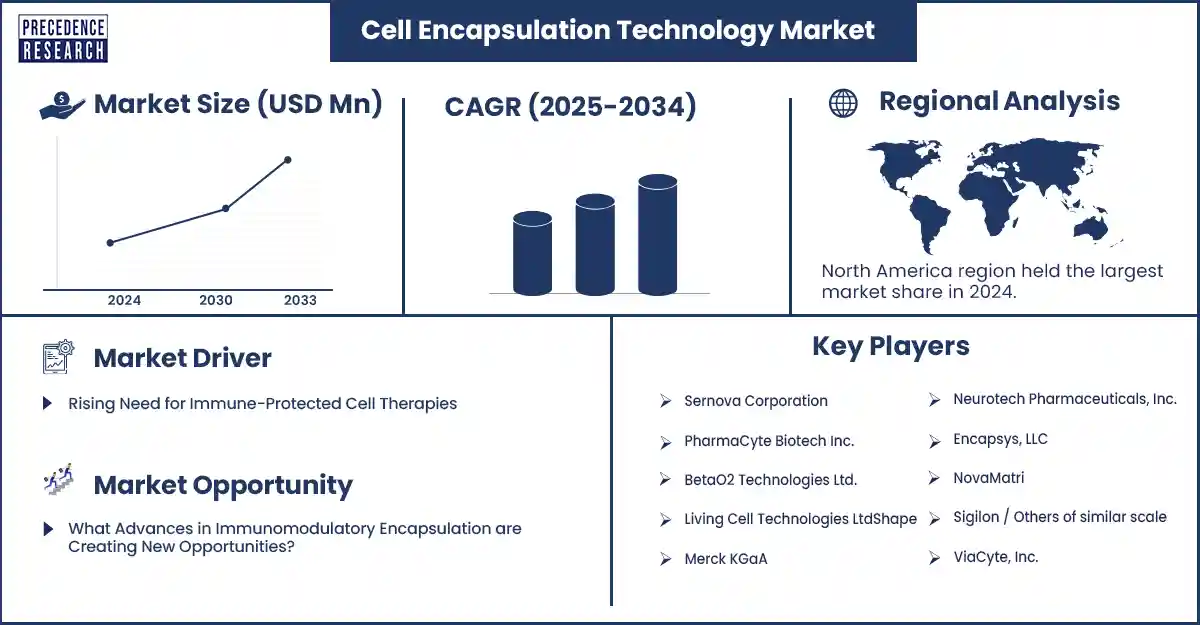Cell Encapsulation Technology Market Revenue and Revenue by 2033
Cell Encapsulation Technology Market Revenue and Trends 2025 to 2033
The global cell encapsulation technology market is driven by the need for advanced drug delivery systems, regenerative therapies, and cell-based treatments. The growth of the market is driven by advancements in cell biology and regenerative medicine, along with innovative technology that is used in various fields, enabling a steady, long-term release of therapeutic products.

Cell Encapsulation Technology Market: Key Drivers & Emerging Opportunities
Cell encapsulation is a biotechnology method involving the enclosure of living cells within a semipermeable, biocompatible matrix or membrane. The market is experiencing significant growth, driven by several key factors. The rising global prevalence of chronic diseases like diabetes and cancer fuels the demand for innovative and sustained treatment options that cell encapsulation can provide. Additionally, increased public and private funding, as well as robust investments in cell and gene therapy research, are accelerating the development of new applications for this technology. Further growth is propelled by continuous advancements in biomaterials and encapsulation techniques, such as microfluidics and 3D bioprinting, enhancing the precision, scalability, and efficacy of encapsulated cell therapies.
Segment Insights
- By encapsulation method, microencapsulation accounted for the market dominance due to its superior surface-area-to-volume ratio, which is critical for the survival and function of encapsulated cells.
- By polymer type, natural polymers dominated the market primarily due to their excellent biocompatibility, biodegradability, and cost-effectiveness, reducing the risk of a foreign body response that can compromise the encapsulated cells.
- By application, the drug delivery segment accounted for the market dominance due to the unique ability of encapsulated cells to provide sustained, targeted, and localized delivery of therapeutics, particularly for chronic diseases.
- By technology, extrusion dominated the market primarily due to its scalability, cost-effectiveness, and versatility, allowing for high-throughput and continuous production of a wide range of encapsulated products.
- By end-user, the pharmaceutical and Biotech segment led the market due to the high demand for advanced drug delivery systems, significant R&D investment, and the pursuit of regenerative medicine for chronic diseases.
Regional Insights
North America dominated the cell encapsulation technology market, stemming from a strong government and private funding, a robust biotech and pharmaceutical industry, and supportive regulatory frameworks. Government agencies in the U.S., such as the National Institutes of Health (NIH), provide substantial funding for regenerative medicine and biotechnology research. This creates an environment where innovations in cell encapsulation can be developed and commercialized rapidly. These companies, including Johnson & Johnson, Pfizer, Merck, ViaCyte, and Sigilon Therapeutics, drive innovation and push for novel delivery systems that require advanced encapsulation.
Asia-Pacific is anticipated to have the fastest growth during the forecast period. This is due to rising investments in biotech research, increasing prevalence of chronic diseases, a large and aging population, and strong government support. Supportive government policies and public-private partnerships are creating an environment ripe for innovation and market expansion. China and India, with their strong manufacturing bases, are playing key roles in this growth.
Cell Encapsulation Technology Market Coverage
| Report Attribute | Key Statistics |
| Quantitative Units | Revenue in USD million/billion, Volume in units |
| Largest Market | North America |
| Base Year | 2024 |
| Regions Covered | North America, Europe, Asia-Pacific, Latin America, and the Middle East & Africa |
Cell Encapsulation Technology Market Key Players
- Sernova Corporation
- PharmaCyte Biotech Inc.
- Beta O2 Technologies Ltd.
- Living Cell Technologies Ltd
- Neurotech Pharmaceuticals, Inc.
- Encapsys, LLC
- NovaMatri
- Sigilon / Others of similar scale
Recent Development
- In January 2024, Biorep Technologies, Inc., and Leiden University Medical Center (LUMC), a modern university medical center for research, education, and patient care with a high-quality profile and a strong scientific orientation, entered a collaboration to bring the PRISM (PancReatic Islet Separation Method) to the diabetes research community represents a significant improvement in islet isolation efficiency. (Source: https://biorepdiabetes.com)
Get this report to explore global market size, share, CAGR, and trends, featuring detailed segmental analysis and an insightful competitive landscape overview @ https://www.precedenceresearch.com/sample/6972
You can place an order or ask any questions, please feel free to contact us at sales@precedenceresearch.com |+1 804 441 9344